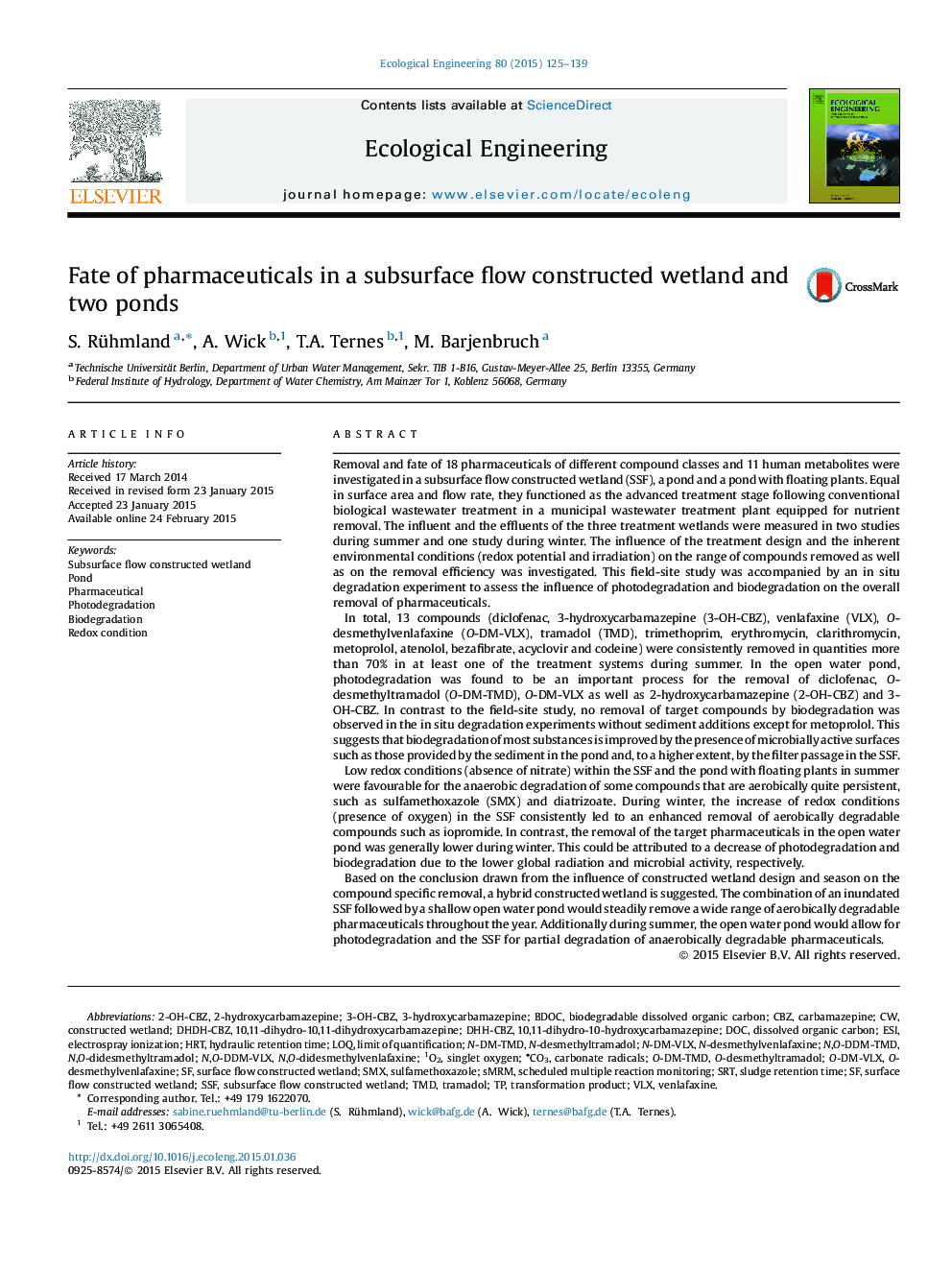| Article ID | Journal | Published Year | Pages | File Type |
|---|---|---|---|---|
| 4389038 | Ecological Engineering | 2015 | 15 Pages |
•Highest removal of photodegradable pharmaceuticals in the pond during summer.•Biodegradation seemed to be improved by the presence of microbially active surfaces.•Seasonally varying redox conditions strongly influence the biodegradation in the SSF.•A hybrid CW is proposed for year-round aerobic degradation of several pharmaceuticals.
Removal and fate of 18 pharmaceuticals of different compound classes and 11 human metabolites were investigated in a subsurface flow constructed wetland (SSF), a pond and a pond with floating plants. Equal in surface area and flow rate, they functioned as the advanced treatment stage following conventional biological wastewater treatment in a municipal wastewater treatment plant equipped for nutrient removal. The influent and the effluents of the three treatment wetlands were measured in two studies during summer and one study during winter. The influence of the treatment design and the inherent environmental conditions (redox potential and irradiation) on the range of compounds removed as well as on the removal efficiency was investigated. This field-site study was accompanied by an in situ degradation experiment to assess the influence of photodegradation and biodegradation on the overall removal of pharmaceuticals.In total, 13 compounds (diclofenac, 3-hydroxycarbamazepine (3-OH-CBZ), venlafaxine (VLX), O-desmethylvenlafaxine (O-DM-VLX), tramadol (TMD), trimethoprim, erythromycin, clarithromycin, metoprolol, atenolol, bezafibrate, acyclovir and codeine) were consistently removed in quantities more than 70% in at least one of the treatment systems during summer. In the open water pond, photodegradation was found to be an important process for the removal of diclofenac, O-desmethyltramadol (O-DM-TMD), O-DM-VLX as well as 2-hydroxycarbamazepine (2-OH-CBZ) and 3-OH-CBZ. In contrast to the field-site study, no removal of target compounds by biodegradation was observed in the in situ degradation experiments without sediment additions except for metoprolol. This suggests that biodegradation of most substances is improved by the presence of microbially active surfaces such as those provided by the sediment in the pond and, to a higher extent, by the filter passage in the SSF.Low redox conditions (absence of nitrate) within the SSF and the pond with floating plants in summer were favourable for the anaerobic degradation of some compounds that are aerobically quite persistent, such as sulfamethoxazole (SMX) and diatrizoate. During winter, the increase of redox conditions (presence of oxygen) in the SSF consistently led to an enhanced removal of aerobically degradable compounds such as iopromide. In contrast, the removal of the target pharmaceuticals in the open water pond was generally lower during winter. This could be attributed to a decrease of photodegradation and biodegradation due to the lower global radiation and microbial activity, respectively.Based on the conclusion drawn from the influence of constructed wetland design and season on the compound specific removal, a hybrid constructed wetland is suggested. The combination of an inundated SSF followed by a shallow open water pond would steadily remove a wide range of aerobically degradable pharmaceuticals throughout the year. Additionally during summer, the open water pond would allow for photodegradation and the SSF for partial degradation of anaerobically degradable pharmaceuticals.
